OLD MANUAL
OLD MANUAL admin Sun, 2022-05-29 06:221. GETTING STARTED WITH PICKMEAPP
1. GETTING STARTED WITH PICKMEAPP1.1. Introduction
1.1. IntroductionPickMeApp is a unique administrative tool to manage all aspects of the Windows software life cycle: Discovering, downloading, installing, running, upgrading, terminating, removing, capturing and transferring applications, with just a few clicks!
PickMeApp discovers and reports on all installed applications, even those which are hidden by the Windows operating system. PickMeApp reveals and summarizes detailed information about installed software, exposing unique data that are not available via other tools.
PickMeApp captures and transfers installed programs from a Windows-based computer to another. The installation packages created by PickMeApp can be used to backup and to restore the applications on Windows computers after reinstalling or recovering Windows. Those installation packages can be also installed on another Windows computer, or several computers, thereby saving the PC administration time.
PickMeApp helps clean up a computer from unnecessary software by silently uninstalling selected applications as well as help to repair malfunctioning software programs. PickMeApp can run or terminate selected applications and all their hidden process and services.
PickMeApp helps to discover and to install new software programs on computer or to upgrade existing installed software. PickMeApp comes with build in repository of free essential applications which could be easily installed on the computer in a row. All included programs are the latest releases linked directly to their original publisher sites. From another hand PickMeApp can work with any custom software repositories managed locally or remotely. The PickMeApp package management functionality eases setup and recreation of Windows computer working environments.
There several advanced features that boost efficiency of PickMeApp as software p life cycle management tool. For example, PickMeApp can create System Restore Points prior operations that may affect stability of system, such as Installing new software, upgrading or uninstalling existing software programs. The rich set of command line commands will help to automate the PickMeApp functionality without need to run PickMeApp interactively. PickMeApp performance could be fine-tuned using advanced settings.
PickMeApp can run as portable application from any removable storage. Alternatively, PickMeApp can be installed on the computer by window installer msi setup. PickMeApp leaves no trace of its usage on Windows. It reads and writes its configuration settings on a file saved under the PickMeApp installation folder.
PickMeApp supports Windows XP and above. It may equally manage software product life cycles of a 32-bit and 64 bit programs on 32-bit or 64-bit Windows computers .
PickMeApp is available in the following product types: PickMeApp Pro, Light and Installer
- PickMeApp Pro has the richest set of software management functionality: discovering, downloading, installing, upgrading, removing, capturing and transferring applications
- PickMeApp Light is tuned to make capturing and transferring applications as simple as possible
- PickMeApp Installer includes almost all essentials features of PickMeApp Pro except ability to capture applications.
A more detailed comparison of the differences between PickMeApp Pro PickMeApp Light and PickMeApp Installer is given in the following section of this manual.
Note: In this manual, unless otherwise mentioned, the term PickMeApp refers to any of PickMeApp products Pro, Light and Installer.
The brief PickMeApp Light usage is giving in chapter 7 of this manual. Details on how to use PickMeApp Light to perform specific software management functions is given included in the same section.
1.2. What is meant by capture and transfer of software programs?
1.2. What is meant by capture and transfer of software programs?The capture of applications enables you to create a personalized software package from programs installed on your PC. This software package is a snapshot of the application itself and its customary settings.
Then this software package may be used to recovery the application on the PC, or to transfer the application on any compatible Windows operating system.
1.3. When is it time to use PickMeApp?
1.3. When is it time to use PickMeApp?- You want to have a backup of your installed programs and their settings;
- You purchased a new computer, and you want to move your customary programs and their settings to a new computer.
- You have to install an application with the same predefined settings on several computers.
- You often reinstall Windows, and you want to save time on the installation of applications.
2. PICKMEAPP SETUP
2. PICKMEAPP SETUP root Sun, 2010-07-18 13:122.1. Download PickMeApp client
2.1. Download PickMeApp client-
Click the “download” icon on the left of nearly every page of the www.pickmeapp.com site.
- For new users a registration dialog will be opened.
- For log-in users a redownload dialog. will be opened. - After filling a registration form or a re-download form you will be able to to obtain the latest version of PickMeApp.
- Download a PickMeApp distribution on your computer, usually named PickMeApp_[version number].exe
-
The distribution is a self-extracting archive guiding you through an easy deployment of the PickMeApp client.
The newest versions of PickMeApp may have additional features and can transfer more applications; therefore, you are advised to update frequently.
VERY IMPORTANT!!!: Each PickMeApp downloaded directly from the PickMeApp site receives an unique PickMeApp ID. Only those PickMeApp installations that have their unique PickMeApp generated by the PickMeApp Site are valid applications. Only those installations can request support, receive updates, and enjoy many other features available for registered users.
2.2. Deployment
2.2. Deployment- Launch the self-extracting archive:
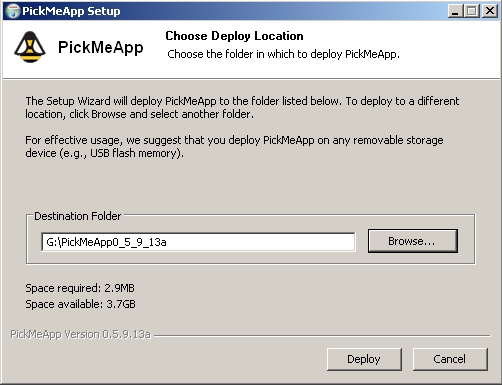
- Extract PickMeApp files to a destination folder on your computer.
PickMeApp was designed as a portable tool. Therefore, for effective usage, we suggest that you deploy PickMeApp to any removable storage device (e.g., USB flash memory).
Note: A destination folder path name needs to be less then 255 characters . ( for example G:\PickMeApp )

- By default, PickMeApp is run when deployment is completed.
3. USING PICKMEAPP
3. USING PICKMEAPP3.1. Starting PickMeApp
3.1. Starting PickMeApp- Following PickMeApp deployment, a program folder named PickMeApp[version number] is created in the chosen location.
- A PickMeApp folder contains configuration files, the PickMeApp executables, and a TAPPS folder for default storage of captured applications.
- To start PickMeApp, run the PickMeApp.exe executable from the PickMeApp folder.
Note: Make sure that you have administrative rights on the computer before attempting to start PickMeApp.
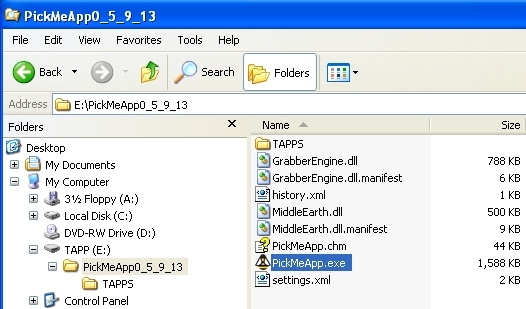
3.2. Running PickMeApp
3.2. Running PickMeAppPickMeApp makes application capture and transfer as simple as possible. The program interface is very straightforward. Usually, you need only three clicks to make capture or transfer operations: Run, Select, Capture or Run, Select , Install.

Left Panel: Installed Applications Panel
The Installed Applications panel lists applications installed on the source computer that PickMeApp can capture.
Right Panel: Captured Applications Panel
The Captured Applications panel lists captured applications and their locations.
Transfer Management Bar
The Transfer Management bar (middle) contains following buttons:
- Capture marked application(s).
- Install marked application(s).
- Create new profile .
Process Bars
Process bars show the status of the capture/deployment processes, and enable the user to interrupt their execution.
Session Log
Session Log provides detailed reports about the PickMeApp execution.
Upper Button Bar
The button bar includes the following:
- Settings: Opens a setting window
- Help: Opens an online help in the browser
- About: Opens a dialog box in which your PickMeApp version number is shown
- Support: Opens a support page in the browser
- Donate: Opens a donation page in the browser
- Update: Checks PickMeApp updates
3.3. Exiting PickMeApp
3.3. Exiting PickMeAppAfter you exit PickMeApp, no trace of its usage will remain in your operating system, outside of the PickMeApp folder.
All PickMeApp settings and captured applications are placed in the PickMeApp folder, ready to be used again the next time you start PickMeApp.
After you have captured an application, all application data is saved in the PickMeApp personalized installation package.
The installation package is contained in a single file with a .tap extension, and includes all the data necessary for the application transfer.
3.4. Updating PickMeApp
3.4. Updating PickMeAppPeriodicaly, PickMeApp checks for new updates.
As soon as a new update is availabe PickMeApp "Update" button will turned red.
Pressing the Update buttion the "Update dialog" will be presented
You may check the content of the update by pressing "Details".
To download update press "Download" button. A download progress dialog will be shown.
After the update will be downloaded you willl see "Install" button.
After installation of a new PickMeApp version you will be asked to restart PickMeApp.
You may check which version of PickMeApp is running by presing "About" button.
3.5. Make Portable PickMeApp
3.5. Make Portable PickMeAppPress "Make..." button to make portable version of PickMeApp.
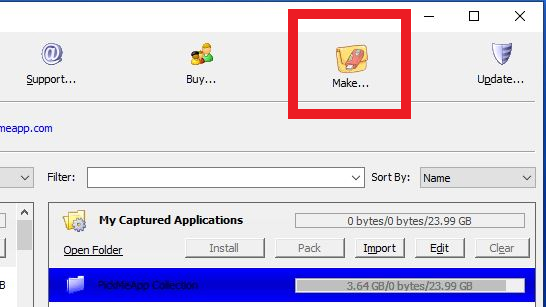
User "Export" dialog to select PickMeApp Profiles you want to have on your portable version of PickMeApp. Once selected press "Export" button to start exporting .
All selected PickMeApp profiles, system files and folders , settings and the license will be exported to the personal portable version of PickMeApp.
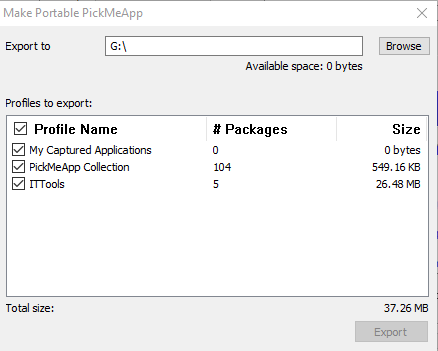
4. CAPTURING AN APPLICATION
4. CAPTURING AN APPLICATION4.1. How does it work?
4.1. How does it work?- Start PickMeApp
- Choose the desired applications from the list and check the box beside them.
- Click the Capture button in the middle bar :
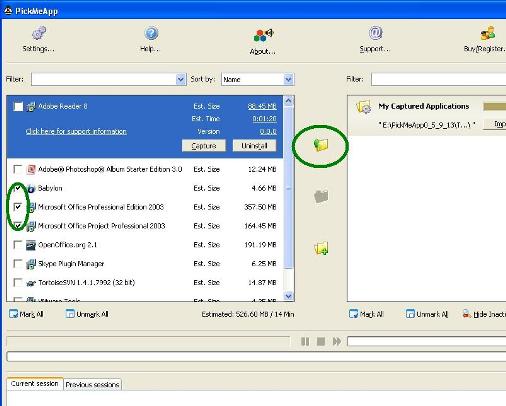
- Wait while the applications are being captured (as indicated in the progress bar).
- When the progress bar turns gray, the transferred applications have been saved in the default profile referenced to the folder TAPPS, located within the main PickMeApp folder.
4.2. Using the Installed Applications list (Left Panel)
4.2. Using the Installed Applications list (Left Panel)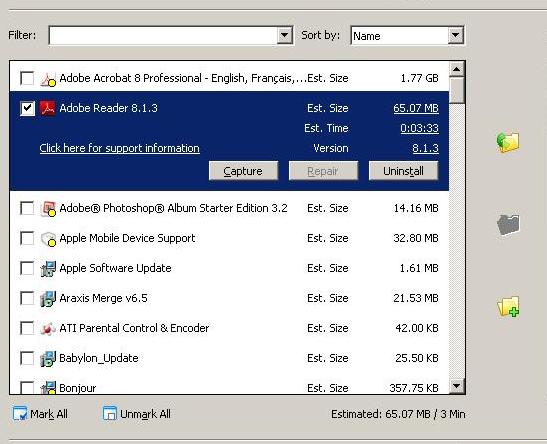
Using the Filter
- Start PickMeApp
- Type some characters from the application name in the filter input line, or choose one of the predefined filtering options*.
- Check the desired applications, or choose the “Mark All” option.
- Click the “Capture” and transfer your application to the default profile.
- During the capture, you can skip/pause an application transfer, using buttons at the progress bar.
- Please wait until the progress bar turns gray, and the “Capturing process finished” message appears.
- <captured> Shows only applications already captured in the selected profile.
- <not captured> Shows only applications not captured in the selected profile.
- <selected> Shows only previously marked applications.
- <clear> Cancels the previous filter, and causes the applications list to revert to the default state.
- <captured> To see applications captured in the current profile.
- <not captured> To select a new application to capture.
- <selected> To see a list of applications you chose to capture.
The Unmark All button
Capturing multiple applications
- Start PickMeApp.
- Using filters or manual selection, check each application to be captured.
- Click the Capture button, and transfer your applications to the default profile.
- During the capture, you can skip/pause an application transfer, using the buttons at the progress bar.
- The capture is complete when the progress bar turns gray, and the “Capturing process finished” message appears.
Using a destination profile
- Start PickMeApp.
- Click on the “Create new profile” button.
- Enter a unique profile name
- Type in the name of a destination path or browse for a unique destination path.
- Click the “OK” button
- Start PickMeApp.
- Choose one of the available profiles in the right panel, and click on the profile name.
- The chosen profile becomes the destination for applications captured.
Marking of installed applications
Installed applications on the list can be marked by a colored circle:
Yellow : the application is currently running
Green : the application is already captured in the current profile on the right panel
Blue : the application is already captured in one of non-active profiles on the right panel
Expanded Application entry
To learn more about an application, click on its name in the application list.
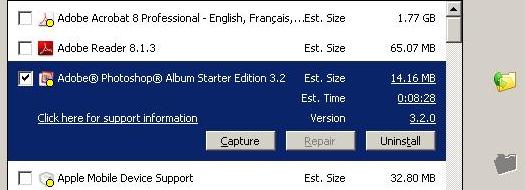
- Est. Size : Estimated size of the application package when captured.
- Est. Time : Estimated time taken for the capture of the application.
- Version : Version of the application, as provided by the application vendor.
- Support Info : Provides a link to detailed information about the application.
- Capture button : Starts capturing the application immediately
- Repair button : Repairs the application. Active only if the repair feature is available.
- Uninstall button : Uninstalls the application from your system *
4.3 Software Suites
4.3 Software SuitesA software suite is a collection of software programs bundled and installed together. The software programs share a similar domain and may have correlative features and functionality, or they may be completely different from one another. After the software suite setup is finished, it can be difficult to determine how those software programs are related and whether they are part of a suite.
Microsoft Office is a popular example. Microsoft bundles multiple software programs like Word (Word Processor), Excel (Spreadsheet), PowerPoint (Presentation Program) and Outlook (email client) into a software suite. Although each of these programs function differently, they are all considered productivity software.
Prior to this PickMeApp version, a software suite user had to manually locate all related software programs, capture them one by one and then recover them onto the target PC. Some of our app workarounds advised users on how to deal with their software suites.
With this Version 1.2. release, PickMeApp is able to identify related software programs as part of a software suite. It lists the software suite under “Installed Application List” alongside the other applications. The user can easily distinguish software suites by their names which starts with “@Suite@” and the bold title fonts. Users can also use the <suites>
Software suites are capturable if all related applications are capturable ( Qualified Applications) . When a software suite is captured, PickMeApp takes all related applications and packages them as a single TAP file or as a single self-extracting executable setup (PickMeApp Light). Software suites are repairable if at least one of its applications is repairable. When a software suite gets repaired, PickMeApp repairs all repairable applications of the software suite. When you uninstall a software suite, PickMeApp uninstalls all related applications.
PickMeApp may fail to find all related applications for a particular software suite, thus losing some its features when transferred by PickMeApp. We constantly improve the PickMeApp abilities to recognize related applications. PickMeApp will only recognize Microsoft software suites as well as predefined custom suites. This limitation will be reduced in the following releases!
4.4 Capture Setup Cache
4.4 Capture Setup CacheTo allow smooth repair and install additional components and features, many software programs cache some installation files on the user’s PC during their first installation.
Since version 1.2, PickMeApp has been able to capture and transfer applications’ installation caches while capturing the applications. Along with the “Check integrity of installed applications” feature, this new function significantly improves application re-installation.
One drawback of the capturing setup cache feature is that the captured package has a larger size. Sometimes it may be twice the initial package size. Also, the capture may take longer time. Disable this feature if you need quicker capturing or a smaller installation package!
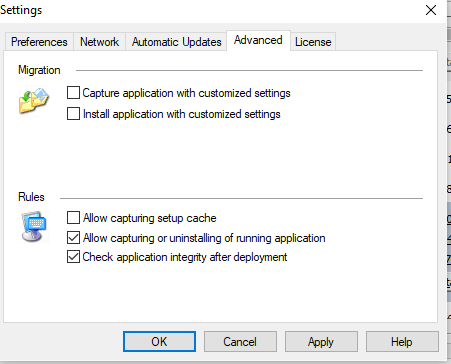
5. DEPLOYING A CAPTURED APPLICATION
5. DEPLOYING A CAPTURED APPLICATION5.0. Pre-deployment checklist
5.0. Pre-deployment checklistIt is recommended to upgrade Windows Installer to version 3.1 when working with PickMeApp.
Many programs require a runtime environment to be installed on the destination system. As for now PickMeApp Beta doesn’t check if the required environment is installed. Therefore it is recommended to download and install the following:
Microsoft Visual C++ 2008 SP1 Redistributable Package (x86)
Microsoft Visual C++ 2005 SP1 Redistributable Package (x86)
5.1. How does it work?
5.1. How does it work?To deploy an application:
- Start PickMeApp.
- Find the required unique package in the destination profile and check the box beside it.
- Click the “Start Installation” button to deploy your application.
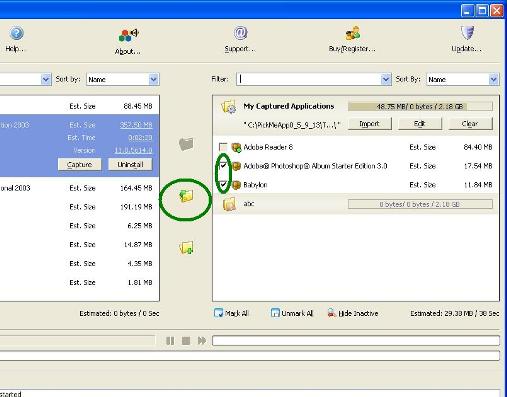
- Wait until the progress bar turns gray, and the “process finished” message appears.
Note: An application cannot be deployed twice.
5.2. Using the Captured Application list (Right Panel)
5.2. Using the Captured Application list (Right Panel)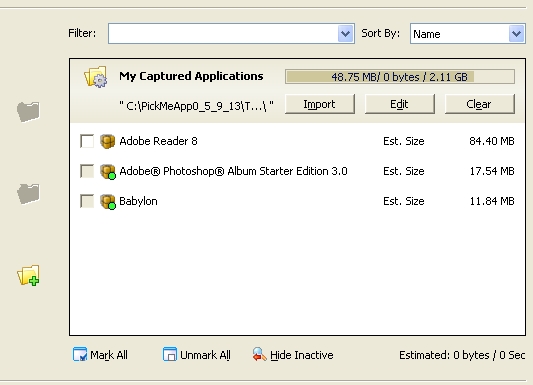
Using the Filter
- Start PickMeApp
- Type some characters from the application name in the filter input line, or choose one of the predefined filtering options.
- Check the desired applications, or choose the “Mark All” option.
- Click the “Start Installation” button to deploy your application.
- Wait until the progress bar turns gray, and the “Installing process finished” message appears.
The Unmark All button
Multiple applications deployment
5.3. Using Profiles
5.3. Using ProfilesProfiles are specific locations where captured applications are stored.
Typically, several profiles for diverse purposes are created (e.g., for backup, mobilization for different platforms, and the like).
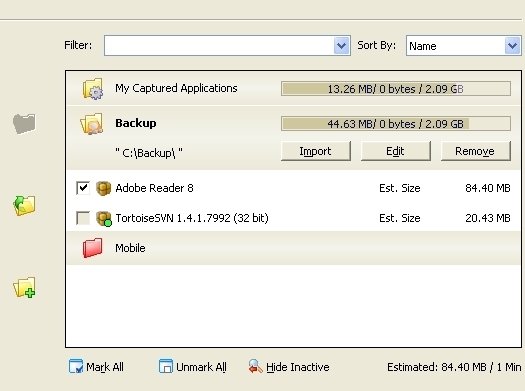
Adding a profile
This option enables you to create an empty profile with a chosen name and location.
When a profile already exists at the location you provided, the applications captured there are automatically included within it.
Import
The Import option allows you to import captured applications and application descriptors. ( .tap , .tad, .pad files) into the selected profile. The files will be copied to the profile folder from its original location.
Note: You may import those files one by one or as set of files. Alternatively you may import a zip archive of those files. ( mix is ok ).
Edit
The Edit option enables you to change the profile name, or its location.
If you change the profile location, all application packages currently in the profile will be imported into the new location from the old one. The former profile will then be deleted.
Remove
The Remove option deletes all applications in the selected profile, and the profile itself.
The default profile cannot be removed.
Hide / Show inactive profiles
If at start PickMeApp does not discover the profile folder in the specified path, it marks the profile as inactive (red folder icon). This may occur because the profile is located on a disconnected mobile drive, or network storage.
You can hide or delete inactive profiles; you cannot edit them.
5.4. Pack (save as exe) feature
5.4. Pack (save as exe) featurePickMeApp Pack /"Save As exe" feature is used to repackage captured application as one installation package. This installation package may be used to install captured applications on any PC at once, without a need of the PickMeApp tool.
Possible Pack /"Save As exe " Feature usages.
- Version Compatibility. PickMeApp is changing rapidly. While we are trying to provide a backward compatibility, it can happen that old captured application packages are not supported by a new PickMeApp version.
- Software Distribution. This feature is especially useful for system administrators. Now PickMeApp can be used to repackage several useful applications as one installation package and to distribute it to other PCs.
- Simplicity. While we are trying to make PickMeapp as simple as possible, yet some users are confused while using PickMeApp. This feature simplifies program and settings transfer task. It makes a re-installation step similar to a standard Windows experience.
Yet to get the most of functionally while re-installing applications on a new PC, consider to use PickMeApp alongside with the original application packages ( TAP files ).
"Save As exe" Feature limitations.
Repackaging
- You can repackage up to 40 applications in one exe package.
-
Repackaging adds about 2MB on top of the original package.
Installation
- You cannot choose which application to install.
- You have only limited information about applications being installed.
- You have no progress notification during installation.
- You cannot cancel installation in the middle of process.
Video Tutorial
Download BestOpenSourceApps installation package from the video !!!
6. PICKMEAPP AS APPLICATION MANAGER
6. PICKMEAPP AS APPLICATION MANAGER6.1. Overview
6.1. OverviewPickMeApp as your ultimate Application Manager.
Now, alongside with programs and settings transfer, PickMeApp helps you to discover, download and install any of existing windows applications with just a few clicks.
PickMeApp is doing it by supporting Portable Application Description (PAD) format as well as our proprietary extension supporting silent , unattended installations of Windows applications.
As an example of PickMeApp usage as Application Manager the PickMeApp distribution includes the PickMeApp Collection of 120 popular one-click installable programs.
All included programs are the latest releases linked directly to their original publisher sites.
- Those applications can be installed at once by PickMeApp .
- All installation work is done in the background.
- Applications are downloaded from each publisher's official site.
- The applications will be installed in their default locations.
- They will not bother you with any choices or options.
- They will be installed without extra junks like toolbars or etc.
- They will skip any reboot requests from installers. So please restart PC manually at the end
Each day we review, test and add new programs to our PickMeApp Collection.
All registered users who frequently install programs using PickMeApp will enjoy automatic updates of our growing PickMeApp Collection.
6.2. Portable Application Description (PAD) format.
6.2. Portable Application Description (PAD) format.Portable Application Description (PAD) is a machine-readable document format designed by Association of Shareware Professionals. It allows software authors to provide product descriptions and specifications to online sources in a standard way, using a simple XML schema that allows webmasters and program librarians to automate program listings. PAD files most commonly have .XML or .PAD file name extension..
Regularly updated PAD files are published by thousands of software information services and software catalogs
The ASP organization maintains PAD repository with more then 200,000 constantly updated software descriptors.
Additionally PAD files can be found in the following repositories.
A standard PAD file may include the following information about an application
- Application Name and Version
- Supported platforms
- Publisher Name
- Download links
- Type of license and EULA
6.3. Quick Introduction to use PickMeAp with PAD files
6.3. Quick Introduction to use PickMeAp with PAD filesTo make PickMeApp to recognize PAD files, the files need to be uploaded to one of PickMeApp profiles.
As soon as a PAD file is uploaded to a PickMeApp profile, PickMeApp is able to read an application description, to download an application package and to run an application installer upon request.
Moreover if a PAD file includes a special PickMeApp extension (TAD), PickMeApp is able to provide a one click install of several chosen applications at once.
To use PickMeAp with PAD files you need to do the following steps:
- Go to software repositories and download PAD files of interesting applications.
- Import PAD files to an existing PickMeApp profile or create a new profile with those PAD files.
- PickMeApp will recognize those files and will list those applications on the Right Panel, alongside with captured applications.
- Now all standard PickMeApp features are applied to application descriptors as well.
6.4. T-APP Application Description (TAD) format.
6.4. T-APP Application Description (TAD) format.T-APP Application Description (TAD) format is an extension of PAD format.
It allows to specify silent or unattended installation instructions
Specification
The following xml tags could be presented in PAD file.
<PMA>
<PMA_Extension_Version>1</PMA_Extension_Version>
<PMA_Silent_Install>
<Type>NSIS| INNO| WIZE | MSI | CMD | TAP | </Type>
<CmdLine> ---silent swithes that should be used if type is CMD, otherwise ---</CmdLine>
</PMA_Silent_Install>
</PMA>
Examples
- 7-Zip TAD extension
<PMA>
<PMA_Extension_Version>1</PMA_Extension_Version>
<PMA_Silent_Install>
<Type>MSI</Type>
</PMA_Silent_Install>
</PMA>
- IrfanView
<PMA>
<PMA_Extension_Version>1</PMA_Extension_Version>
<PMA_Silent_Install>
<Type>INNO</Type>
</PMA_Silent_Install>
</PMA>
- Opera 16.0.11
<PMA>
<PMA_Extension_Version>1</PMA_Extension_Version>
<PMA_Silent_Install>
<Type>CMD</Type>
<CmdLine>/silent /launchopera 0 /desktopshortcut 1 /quicklaunchshortcut 0 /setdefaultbrowser 0 /allusers</CmdLine>
</PMA_Silent_Install>
</PMA>PickMeApp PRO will unpacks the downloaded package in zip format . It will search recursively executable to run setup by following order
a) the first TAP file it finds
b) the first setup.exe file it finds
c) the first exe file it finds
d) the first MSI files it finds
if PickMeApp PRO cannot resolve the correct name <EXENAME> tag should be added with the exact name of the executable to run .
Examples
- Paint.net.4.1.6.install.zip
<PMA>
<PMA_Extension_Version>1</PMA_Extension_Version>
<PMA_Silent_Install>
<Type>CMD</Type>
<CmdLine>/quite </CmdLine>
<EXENAME>paint.net.4.1.6.install.exe</EXENAME>
</PMA_Silent_Install>
</PMA>
6.5. WEB Profiles as Applications Collections
6.5. WEB Profiles as Applications CollectionsTo list a custom remote collection of applications define Web Profile and set remote link that list all urls on PAD files of the applications.
PickMeApp Collection of Essentials Programs
https://pickmeapp.com/pmapads/pmafc.txt
Existing Application Collections
- http://www.masterslabs.com/padmap.txt
- http://download.seiz.ch/padmap.txt
- http://www.ab-tools.com/pad.txt
- https://xfx.net/padmap.txt
- http://www.abhisoft.net/pad/padmap.txt
- http://www.amigaforever.com/pad.txt
- http://www.artistscope.com/pad/pad_map.txt
- http://www.batchwork.com/pad/padmap.txt
- http://www.bigasoft.com/pad/padmap.txt
- http://www.binaryboy.com/pads/padmap.txt
- http://www.bksoft.de/padmap.txt
- http://www.cayoren.com/padmap.txt
- http://www.cyber-wit.com/padfiles/
- http://www.cybermatrix.com/pad/pads.txt
- http://www.diafaan.com/padfiles/
- http://www.digitalliquid.com/pad/padmap.txt
- https://www.digitalvolcano.co.uk/download/padmap.txt
- https://www.e-systems.ro/padmap.txt
- http://www.easy2sync.com/padmap.txt
- https://www.grsoftware.net/PADmap.txt
- http://www.gsa-online.de/files/pad.php
- http://www.gssezisoft.com/padmap.txt
- http://www.hotbounce.com/pads/hotbounce-padlist.txt
- http://www.info2000.biz/pad/allPads.txt
- https://www.infordesk.com/products/pad_list.txt
- https://www.m2osw.com/padfile/
- http://www.marshallsoft.com/padfiles.txt
- http://www.masterslabs.com/padmap.txt
- http://www.nirsoft.net/pad/pad-links.txt
- http://www.nuonsoft.com/pad/master_pad.txt
- http://www.peterssoftware.com/padinfo/padmap.txt
- http://www.phdcc.com/download/padmap.txt
- http://www.rttsoftware.com/padfiles.txt
- http://www.servolutions.com/pad/allpadfiles.txt
- http://www.sharktime.com/pad/padmap.txt
- http://www.sprintbit.com/other/pad/pads.txt
- http://www.stoik.com/pad/padmap.txt
- http://www.top-password.com/PAD/padmap.txt
- http://www.turnwatcher.com/padfile
- http://www.wernerr.de/software-free/padmap.txt
- https://wonderwebware.com/padmap.txt
- http://www.treepad.com/pad/padmap.txt
- https://wammu.eu/api/pad/padmap.txt
- https://bluefive.pairsite.com/pad.txt
- http://www.nuonsoft.com/pad/master_pad.txt
How to create you own list?
- Create simple plain text file containing all PAD URLs from application collections.
- Put it on some storage, remote or local
- Add Web Profile with link pointing to that file
PickMeApp Pro supports http://, https://, ftp://, file:// protocols
6.6 Guessing silent Installation or Removal of Applications
6.6 Guessing silent Installation or Removal of ApplicationsPickMeApp PRO can try to guess the type of installers used to install or package the application to apply known silent installation or uninstallation switches to the application.
Guess mode is enabled or disabled using Advanced Settings dialog .
If Guess mode is enabled PickMeApp PRO will allow
- to unistall silently those applications which installer type was identified.
- to install silently those applications that are described by PAD format
When Guess mode is disabled all installations or uninstallations of applications are interactive, except for applications which type is explicitly known. ( qualified applications, captured applications or applications described using TAD format).
Note Disable guess mode to install or to remove programs interactively.
While installing and uninstalling silently applications PickMeApp PRO will try to identify if applications do not behave silently by monitoring opening dialogs of application. if application setup does not behave silently PickMeApp PRO will skip installing or uninstalling that application. It will move to the next application, leaving open dialogs intact to allow user to complete the actions manually.
6.7. Analyze installed software programs
6.7. Analyze installed software programsNote: The following feature is only relevant for the PickMeApp Installer.
PickMeApp Installer offers a unique feature that analyzes if installed software programs are supported by PickMeApp.

The information about installed software programs is sent to PickMeApp servers for analysis on whether they are supported by PickMeApp. Those software programs are compared with all known software programs successfully transferred by PickMeApp.
The final report is sent to the email provided in the "Analyze installed software programs" dialog.
To send a request for supportability analysis, complete the following:
- Press the “Analyze” button located on the upper bar of the PickMeApp Installer.
- Provide an email address where the final report should be sent.
- Press the “Send” button.
Once the PickMeApp server finishes its supportability analysis, the detail report is sent by email.
Note: Only one analysis request per 15 minutes can be sent.
Using this feature, it is possible to verify if PickMeApp Pro or Light can capture and transfer your applications without having to purchase the license.
7. PICKMEAPP LIGHT
7. PICKMEAPP LIGHT7.1 PickMeApp Light Review
7.1 PickMeApp Light ReviewPickMeApp Light is about 50% of a full PickMeApp functionality.
PickMeApp Light captures and saves installed programs as single executable installation.
You may use this installation package to re-install your program on another PC without PickMeApp usage by coping and running this executable on a destination PC. The setup will guide you through reinstallation process.
Note PickMeApp Light cannot create packages larger than 2GB.
7.2 Unattended/Silent Installation of captured application.
7.2 Unattended/Silent Installation of captured application.PickMeApp Light captures and packages installed programs as single executable setup.
This setup can be run in interactive mode as well unattended/silent mode using /S switch.
For example running "KeePass 2.39.1.exe /S" in a command line to install captured KeePass silently.
The following InstallSilent.bat script can be used to automate installation of captures software programs.
(The script can be located in the "Tools" directory of PickMeApp Light setup).
:: To call installing in silent mode, we can call like :: InstallSilent.bat "7-Zip 9.38.exe" @ECHO OFF start "" /WAIT %1 /SD Echo. IF %ERRORLEVEL% == 0 ( Echo The application was installed succufuly. ) Else If %ERRORLEVEL% == 1 ( Echo Installation ended with error. ) Else If %ERRORLEVEL% == 2 ( Echo Installation failed. ) Else If %ERRORLEVEL% == 3 ( Echo Permission Denied. ) Else If %ERRORLEVEL% == 4 ( Echo License is Invalid. ) Else If %ERRORLEVEL% == 5 ( Echo Installation canceled. The program is already installed on the computer. ) Else Echo Failed without reason Echo.
7.3 PickMeApp Light vs PickMeApp
7.3 PickMeApp Light vs PickMeAppA full version of PickMeApp Application Manager allows you:
- Select and capture many programs at once
- Select and reinstall many captured programs at once
- Create a single executable installation for several programs at once
- Select and install many new programs at once.
- Manage separate profiles for different captured programs and new installations.
- Receive automatic updates.
- Submit request and receive online support.
Note: Currently there is no difference between PickMeApp and PickMeApp Light in supported applications.
8. CONFIGURATION
8. CONFIGURATION8.1. User Interface Preferences
8.1. User Interface Preferences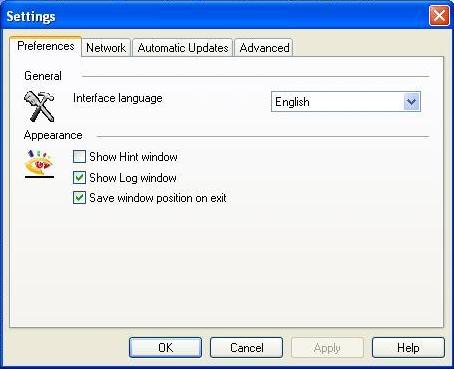
PickMeApp is available in the following languages:English, Italian, Vietnamese, German, Slovenian, Polish, and French.
8.2. Network Preferences
8.2. Network Preferences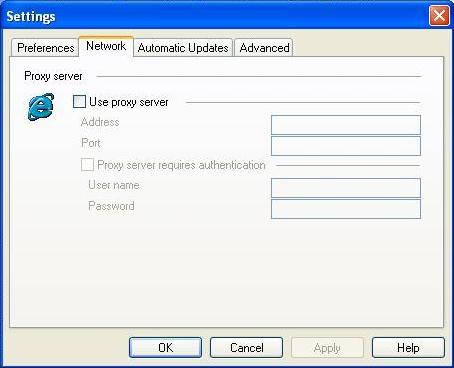
In the Settings window, you can configure your proxy server, if you need one to get through your company's firewall.
8.3. Automatic Updates configuration
8.3. Automatic Updates configuration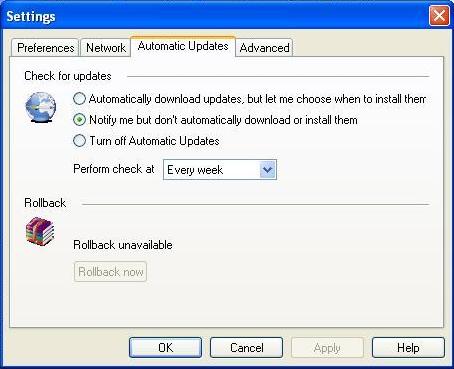
You can enable an automatic check for PickMeApp updates, and specify the manner in which the check will proceed.
There is also an option to rollback to a previous PickMeApp version.
8.4. Advanced options
8.4. Advanced options
You can enable capture and installation of an application with the current custom user settings. This is an experimental feature.
To make application capture safer you can disable capturing of applications that are currently run.
To make an installation process quicker you may disable a PickMeapp checking integrity of installed applications.
Note: some of applications are fixed automatically by PickMeApp during that test.
8.5. PickMeApp Command Line Interface
8.5. PickMeApp Command Line Interface
You can work with the PickMeApp using command line. PickMeApp supports the following convention
General Conventions
- All parameters in <> are mandatory parameters . we need to specific them.
- All parameters in [ ] are optional parameters . it's possible to ignore them.
- Path with space should be in " "
- Alll CLI commands should include email and password in form /a <PMA Id>.<email> to indicate license information.
- Most of actions switches are one letter + one letter for transformation of action ( e.g /i +d = /id - start install but download only )
- Customization are started from switch /c+ letter per customization settings ( /c+b+m = /cbm )
- Add /log with the path to log file to print logs of each CLI command.
- PickMeApp Pro setup includes PickMeAppPro.bat - which is preferable way to use PickMeApp CLI as it prints status messages in CMD.
- All actions except listing installed applications require Product ID ( e.g {85F4CBCB-9BBC-4B50-A7D8-E1106771498D} ) . The Product ID can be obtained by listing installed application command
List installed applications /l switch
PickMeAppPro.bat /a <PMA Id>.<Email> /l /c([n][q][a][s][f]) [/suite <external suite path> ] [/appname <Name>] [/apppublisher <publisher>] [/thresholdname <threshold value>] [/thresholdpublisher <threshold value>] [/pkgs <package folder>] [/log <path to the log file>]
/c - specifies customization flag for List
[n] - Non Qualified Applications
[q] - Qualified Applications
[a] - all installed Applications
[s] - Suites
[f] - Filter/Search installed apps fuzzy match based on thresholds by following attributes:
/appname - Indicate the name of installed application. (above the threshold).
/thresholdname - Threshold for application name
/apppublisher - Indicate the name of Publisher of installed application (above the threshold).
/thresholdpublisher - Threshold for Publisher name
/suite - Indicate external suite ini file
/log - Indicate log file output
/pkgs <package folder> - Indicate package folder, you have to specific a folder that is keeping packages such as xml, tap, pad, exe, msi.
if /pkgs switch is used the output is cvs file with information about of packages located in the folder
The output of List installed Application command is csv file with information about installed applications specified by filters
Example: List all installed apps . and log is put to c:\
PickMeAppPro.bat -a fdb234514182afdead32ad5hhhahah380d.test@gmail.com /l /ca /suite c:\suite.ini /log c:\log.txt
Capture installed applications /g switch
PickMeAppPro.bat /a <PMA Id>.<Email> /g[p] [/c([f][r][h])] <Product ID> /out <Output Folder> [/suite <external suite path> ] [/log <path to the log file>]
[p] - Packing the grabbed image to exe installation file
/c - specifies customization flag for grab
[f] - processes file settings
[r] - processes registry settings
[h] - Indicate that the capturing will be not included MSI Caches
/out - Indicate output folder
/suite - Indicate external suite ini file
/log - Indicate log file output
Example:
PickMeAppPro.bat -a da806f519766f914d333d5d0abd16b93.testemail@gmail.com /gp /ch {23170F69-40C1-2702-1900-000001000000} /out c:\test /log c:\test\log.log
Uninstall applications /u switch
PickMeAppPro.bat /a <PMA Id>.<Email> /u [/c([b][m])] <Product ID> [/suite <external suite path> ] [/log <path to the log file>]
/c - specifies customization flag for uninstsall
[b] - indicate to turn-on creating system restore
[m] - indicate to turn-on Guess mode
/suite - Indicate external suite ini file
/log - Indicate log file output
Example
PickMeAppPro.bat -a da806f519766f914d333d5d0abd16b93.testemail@gmail.com /u {23170F69-40C1-2702-1900-000001000000} /log c:\test\log.log
Install package /i switch
PickMeAppPro.bat /a <PMA Id>.<Email> /i[d] [/c([f][r][k][l][b][m])] <Package> [/downloadpath <path to download folder>] [/log <path to the log file>]
[d] - Indicate downloading only. Do not perform installing.
/c - specifies customization flag for grab
[f] - processes file settings
[r] - processes registry settings
[k] - Indicate that the downloaded package will be stored in local machine
[l] - Indicate that the downloading package from local machine (If not parameter, downloading order is WEB)
[b] - indicate to turn-on creating system restore
[m] - indicate to turn-on Guess mode
/downloadpath - Indicate folder to be used to store any downloaded file. (default is current working folder) . the download folder is used to stored any downloaded files when installing via pad/xml file. This folder is similar to working folder and required for the install action when pad/xmal packages are installed
/out - Indicate output folder
/suite - Indicate external suite ini file
/log - Indicate log file output
Example
PickMeAppPro.bat -a da806f519766f914d333d5d0abd16b93.testemail@gmail.com /id /ck C:\Pad_Test\KeePass_pad.tad /downloadpath C:\Pad_Test /log c:\test\log.log
Relocate Installed Application /r switch
PickMeAppPro.bat /a <PMA Id>.<Email> /r <Product ID> <Relocated drive> [/suite <external suite path> ] [/log <path to the log file>]
<Product ID>: Indicate a moving product
<Relocated drive>: Destination drive
/suite - Indicate external suite ini file
/log - Indicate log file output
Example:
Relocate "Orca" to drive E
PickMeAppPro.bat -a da806f519766f914d333d5d0abd16b93.testemail@gmail.com /r {85F4CBCB-9BBC-4B50-A7D8-E1106771498D} e:
Remain relocated application /m switch
PickMeAppPro.bat /a <PMA Id>.<Email> /m <Product ID> [/suite <external suite path> ] [/log <path to the log file>]
<Product ID>: Indicate a moving product
<Relocated drive>: Destination drive
/suite - Indicate external suite ini file
/log - Indicate log file output
Example:
Remain "Orca"
PickMeAppPro.bat -a da806f519766f914d333d5d0abd16b93.testemail@gmail /m {85F4CBCB-9BBC-4B50-A7D8-E1106771498D}
Pack ( Save as Exe) /p switch
PickMeAppPro.bat /a <PMA Id>.<email> /p <Destination> [/n <outputName>] <Package 1> [ <Package 2> <Package 3> ... ]
<Destination>: output folder and the Packing log will be stored in here.
[/n <outputName>]: output file name (if not input output name, The name of first package will be used)
<Package 1>: tap/pad file 1
<Package 2>: tap/pad file 2
Example:
Packing 7-Zip tap and KeepPass pad file
PickMeAppPro.bat -a da806f519766f914d333d5d0abd16b93.testemail@gmail /p c:\test /n testApp c:\test\7-Zip.tap c:\test\KeePass_pad.xml
9. TROUBLESHOOTING
9. TROUBLESHOOTING9.1. PickMeApp fails to capture an application
9.1. PickMeApp fails to capture an applicationCheck that there is no other install/uninstall operation in progress.
Check that the application to be captured is not running.
Check that you have an administrator rights on the computer.
Check that the application is not listed as Currently not Supported
Restart PickMeApp and try again. If the problem persists, report it to the PickMeApp support service.
Note: Some applications cannot be captured / installed due to their dependency on specific hardware configurations.
9.2. PickMeApp fails to deploy an application
9.2. PickMeApp fails to deploy an applicationCheck that the application is not listed as Currently not Supported
Ensure that there is no other version of the same application on the computer.
Check that you have an administrator rights on the computer.
For better comparability we recommend to switch off UAC before running PickMeApp.
You may enable UAC after finishing deployment.
9.3. Applications installed on the computer are not present in the left panel
9.3. Applications installed on the computer are not present in the left panelPickMeApp show all applications by dividing them on
- Qualified Applicaitons - applications PickMeApp can capture
- non-Qualified Applications. - other applications.
Check that the application is located in Qualified Applicaitons profile .
Check that the application is located in non-Qualified Applications profile .
Check that the application is not hidden by a current filter.
Check that you are using the latest version of PickMeApp.
9.4. PickMeApp hangs during or after capture/installation
9.4. PickMeApp hangs during or after capture/installationCheck that there is no other install/uninstall operation in progress.
Ensure that the application to be captured/installed is not running.
Restart PickMeApp and try again. If the problem persists, report it to the PickMeApp support service.
9.5. After deleting an application from the installed applications list (left panel), it is still listed there
9.5. After deleting an application from the installed applications list (left panel), it is still listed thereRestart PickMeApp and try again.
9.6. PickMeApp does not allow you to choose an application to create a personalized package
9.6. PickMeApp does not allow you to choose an application to create a personalized packageThis application has already been captured within the currently active profile. Either remove the application from the active profile, or select another profile.
9.8. PickMeApp does not remove an application installed on your computer
9.8. PickMeApp does not remove an application installed on your computerIt is possible that the application registration entries are corrupted. Try to remove the application using its own uninstall option, or via the add/remove programs option in the control panel.
9.9. PickMeApp does not show the Profile Name, or the personalized packages are not present
9.9. PickMeApp does not show the Profile Name, or the personalized packages are not presentCheck that the profile location is accessible, and the profile folder is there. Check that all package files are in the profile location.
Add the profile again using the “Create New Profile” button, and supplying a path to the profile location.
10. PICKMEAPP AS SOFTWARE UPDATER
10. PICKMEAPP AS SOFTWARE UPDATER admin Wed, 2020-04-01 09:3310.1 PickMeApp software updater Overview
10.1 PickMeApp software updater OverviewPickMeApp keeps your installed applications up-to-date.
PickMeApp’s full range of software management functionality makes PickMeApp the most advanced and the best software updater tool in the market. Here’s why:
- Scan and lists your outdated software
- Upgrades are downloaded and installed with just one click
- Upgrades are downloaded from the program's original source
- Create a system restore point that rolls back to previous updates whenever required (available on-demand in the Pro version only)
- Portable and non-portable modes (Pro version only)
- Built-in advanced Uninstaller
- Supports thousands of software programs via built-in and/or custom App Stores
- Works smoothly with all Windows versions, including Windows 10/8/8.1/7/XP/Vista
The outdated programs will be marked by red exclamation mark "!".
Alternatively the upgradeable filter can be used to find programs that can be upgraded.
It is possible to upgrade one or several applications in a raw by pressing "Upgrade" button.
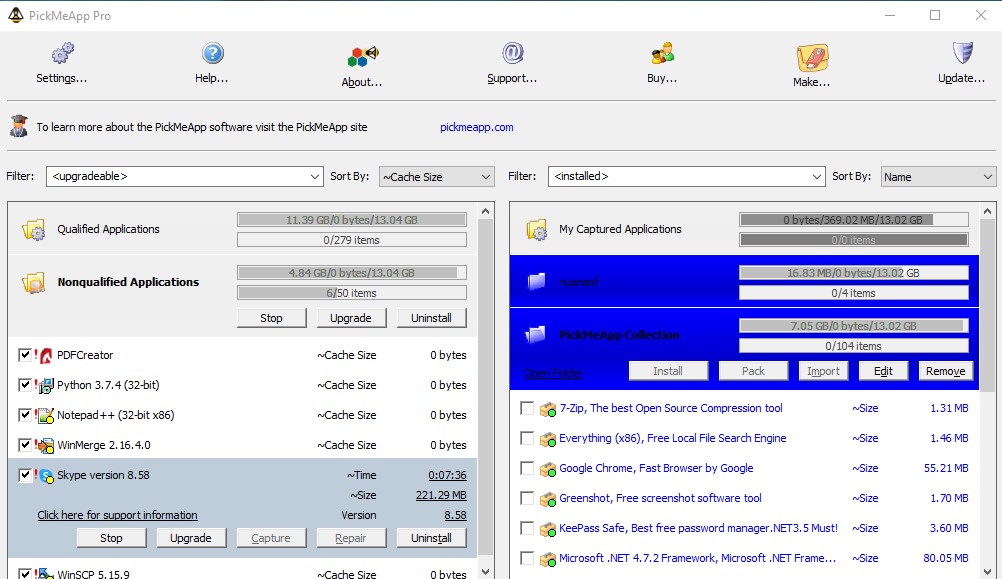
Upgrades will be available for any software programs installed from PAD packages located in one of PickMeApp Profiles ( see more explanation in the following paragraph)
For example
Any application from PickMeApp Collection once installed on the computer will be monitored for upgrades.
To make sure that installed software will be monitored for upgrades, import its PAD package to one of PickMeApp profile . As reminder the official PAD repository (http://repository.appvisor.com/) contains more than 15,000 software titles.
It is ok to import corresponding PAD package even after application was already installed.
11. RELOCATE INSTALLED SOFTWARE TO ANOTHER DRIVE
11. RELOCATE INSTALLED SOFTWARE TO ANOTHER DRIVEMany Windows computer users with small SSD system disks (128 – 256 GB) are falling into the same trap: Although the initial hardware requirements for the operating system installation seemed sufficient with these disks (about 20 GB for Windows 7/8 and 40 GB for Windows 10), the continued usage of Windows OS gradually uses up any free space left on the disk.
At first, Windows users feel safe installing software on their default drive, even when it only has 128GB of storage space. In addition, Windows updates, drivers, settings, application and system caches, logs and user files are all saved on the system disk as well. After 1-2 years of running Window OS with a small SSD, most Windows users run out of free space on the system disk.
While it is possible to free space by moving personal files onto an additional larger disk, about 80% of space on the system disk would be still occupied by installed software and system files.
Uninstalling and reinstalling software on a new disk seems like a tedious and error prone solution in this situation. The better solution would be to relocate installed software to a new disk as-is. Eventually, Windows provided a built-in technology that makes such relocation possible. The technology, called junction points, allows a Windows user to anchor the paths of some source folders on one disk to the target folder on another disk. Users can free up space on their system disk by moving application folders’ content to another drive and anchoring their original locations to the new folders. This allows them to keep the rest of their application components like shortcuts, registries, and configurations.
PickMeApp provides an intuitive and user-friendly solution to move installed programs to another disk. Once a user chooses to relocate one or several installed applications, PickMeApp takes on all necessary operations necessary to perform the relocation of an installed software.
PickMeApp calculates required disk space, identifies application folders that are safe to relocate, moves applications folders to a new destination, cleans up leftover data and confirms application integrity after relocation. PickMeApp may undo any unsuccessful relocation and keeps the computer save state throughout the relocation process. In some cases, restarting the computer and running PickMeApp again is required to complete a relocation.
Relocated software works seamlessly with management operations such as running, terminating, capturing, uninstalling, and upgrading installed software. After uninstalling an application, PickMeApp will cleanup any leftover application data and will preserve relocated applications after the upgrade in most cases. Users can always revert the relocation by installing software back to its original installation location.
PickMeApp supports relocating applications on all Windows operating systems with NTFS drivers, starting from Windows XP SP3 and up. By using PickMeApp to move applications on another disk, users will effectively free up 95-99% of system disk space that was previously occupied by installed applications. In future releases, PickMeApp will provide a solution for freeing even more space, which will further prolong the life span of Windows computers with small SSD disks.
11.1 Relocation settings
11.1 Relocation settingsTo enable the relocation feature, select a destination drive in the Relocation Tab of the Settings menu. The destination drive is used as the destination for relocated application files and folders.
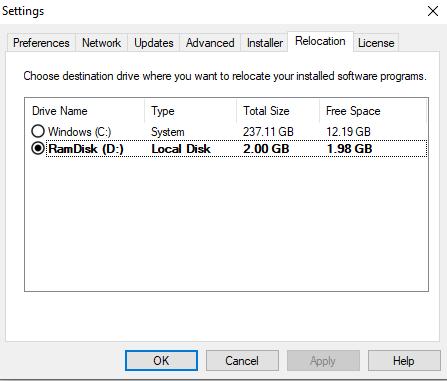
The Relocation settings tab shows a sorted list of compatible drives available on the computer. The first drive on the list is the drive with the most available storage space. The drive that is currently chosen as the destination drive is show in bold.
The list does not include non-NTFS and removable drivers. No drive can be chosen if there is only one compatible drive available on the computer, and the relocation feature is disabled. A driver without free space cannot be chosen as a destination drive.
Note: The relocation feature is enabled on computers with two or more non-removable NTFS drivers.
Select the destination drive in the drive list and press the “Apply” or “OK” buttons to save your choice. From that point on, any new relocations are done on that destination drive. The PickMeApp Session log will then show the following message:
“Drive <name of drive><Disk Label:> was chosen as relocation destination.”
Note: If a destination driver was deleted, select a new destination drive to enable the relocation feature.
11.2 Relocate installed Application
11.2 Relocate installed ApplicationRelocate Single Application
Once a destination drive is chosen, you may start the relocation of a single application by pressing the “Relocate” button available on the Application Bar of any installed application (Qualified and Non-Qualified).

Note: You cannot relocate an application that is originally installed on the destination drive (e.g., disk C:).
PickMeApp starts the relocation of an installed application by ending all running application processes. Please make sure you have saved all application documents prior to starting the relocation process.
The relocation may last from a few seconds to several minutes, depending on the size of the application and speed of the source and destination drivers. In some cases, you may experience a short period of desktop flickering. This happens when PickMeApp is trying to release some locked files prior to the relocation.
Note: It is important that during relocation, the computer is not accidentally switched off (e.g., pressing the power button), otherwise the application may end up in a non-operational state.
Software suites (e.g., Microsoft Office) are handled as a single application. All applications in a software suite are relocated at once.
In some cases, you may be prompted to restart your computer and to run PickMeApp again to finalize the relocation of applications. You may restart computer once per several relocations.

Make sure to run PickMeApp again after the computer restarts. PickMeApp Light and portable PickMeApp Pro users must manually run PickMeApp again. PickMeApp Pro users that enabled starting PickMeApp during computer startup will have the PickMeApp automatically restart.

Relocate Several Applications
PickMeApp Pro can relocate several selected installed applications at once.
Select the applications that you want to relocate and press the “Relocate” button available on Qualified and Non-Qualified applications profiles. The selected applications are now relocated one by one. You can stop or skip the relocation of applications during the process.
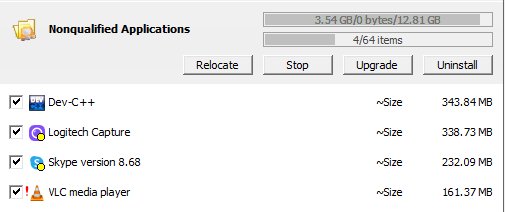
Make sure to restart the computer and run PickMeApp again if at least one application relocation requires a computer restart.
Relocated Applications Filter
You may find relocated applications by applying the <relocated> filter in the Filter Bar.
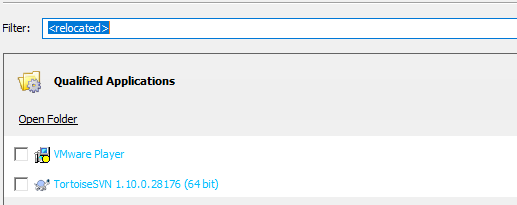
The <relocatable> filter helps find applications that can be relocated to the destination drive. The filter excludes applications that are installed on the current destination drive (e.g., disk C:).
Relocated Applications Info
To see detailed information about a relocated application, click the “Support information” link at the Application Bar, along with other detailed info about the application the dialog provides:
- The size of the relocated folders (the freed-up space from the original disk)
- The destination drives.
- The relocated folders and their status
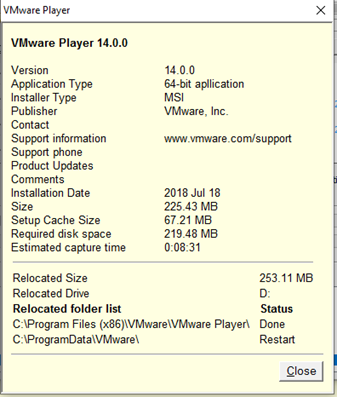
11.3 Remain Relocated Application
11.3 Remain Relocated ApplicationRemaining applications means to return application folders to their original location after relocation.
After an application is successfully relocated, the font color of each relocated application is changed to blue font and the Relocate button is changed to the Remain button.
Note: The Remain button is disabled for relocated applications waiting for a computer and PickMeApp restart.
The Remaining action is very similar to the relocation of application. The remaining process may last from a few seconds to several minutes, depending on the size of the application and speed of the source and destination drivers. In some cases, you may experience a short period of desktop flickering. This happens when PickMeApp is trying to release some locked files prior to remaining the application.
Remaining applications may require restarting the computer to clean up the remaining data from the relocation. In such cases, PickMeApp prints information message inside the Session Log. The “Restart” pop-up is not shown.
Note: The remaining application fails with an error message if there is not enough space left on the original drive.
Note: You can only remain applications one at a time. There is no batch mode available for remaining applications.
11.4 Creating System Restore Points
11.4 Creating System Restore PointsWe strongly recommend creating Windows Restore Points prior to relocating an application. PickMeApp Pro users have access to the “Create Restore Points per PickMeApp Action” feature described here: (link).
To learn more about how to create Windows Restore Points, follow this link: (link).
11.5 Command Line Interface for Relocate
11.5 Command Line Interface for RelocatePickMeApp Pro users can run relocate and remain actions using command line. Two new CLI switches "/r" and "/m" are available to relocate and remain applications (see the PickMeApp CLI for more info).
It is possible to relocate a previously relocated application to another drive by using CLI. This option is not available via PickMeApp UI.
11.6 Managing relocated applications
11.6 Managing relocated applicationsRunning and Closing relocated applications
There should be no difference in running or closing a relocated application. You can create shortcuts and add them to the start menu the same way as you would with a non-relocated application.
Uninstalling relocated application
The best way to uninstall a relocated application is to use the PickMeApp Uninstall Feature described here: (see link)
To allow a proper clean up after uninstalling a relocated application, make sure that PickMeApp is running during the uninstall process.
In a case when a relocated application was uninstalled while PickMeApp was not running, the application’s relocated files and folders might be left on the destination folder. A manual cleanup will be required in this scenario.
Upgrading relocated application
There are two scenarios for application upgrades:
- The upgrade setup overwrites application files by using new files without altering folder locations. The PickMeApp Relocate feature is designed to support the process in this case. The upgraded application is still relocated after the upgrade, although some new application folders might not be relocated.
- The upgrade setup uninstalls the old application and then installs the new application version. Currently, PickMeApp cannot distinguish that scenario from a regular uninstall. The newly installed version of the application is not relocated. To keep the application relocated, repeat the relocation process.
11.7 Relocation Feature Troubleshooting
11.7 Relocation Feature TroubleshootingIf you need to contact PickMeApp support about relocation or remain installed applications , please provide PickMeApp Support with the following files:
- Log files located at %appdata%\PickMeApp
- GDPR records located at the hidden folder $PmaData at %systemdrive%
12. PickMeApp as Application Launcher
12. PickMeApp as Application LauncherPickMeApp as Application Launcher
In line with our goal to make PickMeApp the ultimate Windows Application Manager for everyone, PickMeApp is adding a new capability of launching and terminating installed applications with just one click.
PickMeApp’s detailed knowledge of application components allows PickMeApp to locate and start any executable of the installed software on your PC. PickMeApp can also identify and terminate any running process of the selected application on demand. PickMeApp even handles hidden application services running in the background that are consuming computer resources.
You can manage an application’s start and stop by using the “Start” and “Stop” buttons on the PickMeApp application bar. Also, you can terminate several applications at once by using the “Stop” button on the System profile bar.
If an application has a single executable, PickMeApp shows those buttons with normal text. If an application has several executables or services, the “Start” and “Stop” buttons are shown in bold text.
If several executables belong to the same application, PickMeApp allows users to choose which executable to start or to stop. PickMeApp groups these executables by type to simplify their management. The essential application executables can easily be reached by one click. Rarely used executables are grouped together by default.
Alongside with starting executables, PickMeApp starts any essential application services needed to run those executables. On the other hand, it is possible to completely terminate all of an application’s processes and services to save computer resources.
PickMeApp provides detailed application info about application executables, services, running statuses and whether they are setup to run after computer startup. PickMeApp allows you to filter and select several running applications for batch management .
PickMeApp CLI interface is extended to support starting and stopping of applications from the command line.